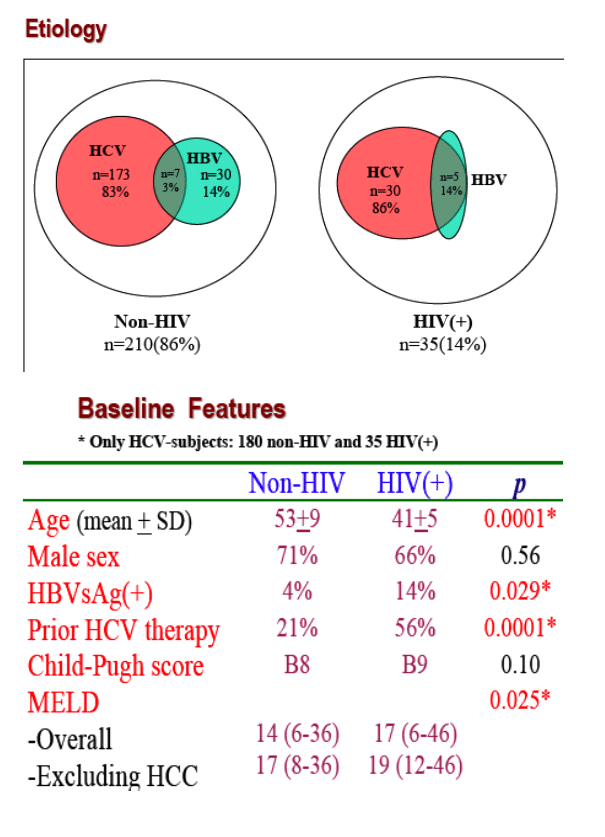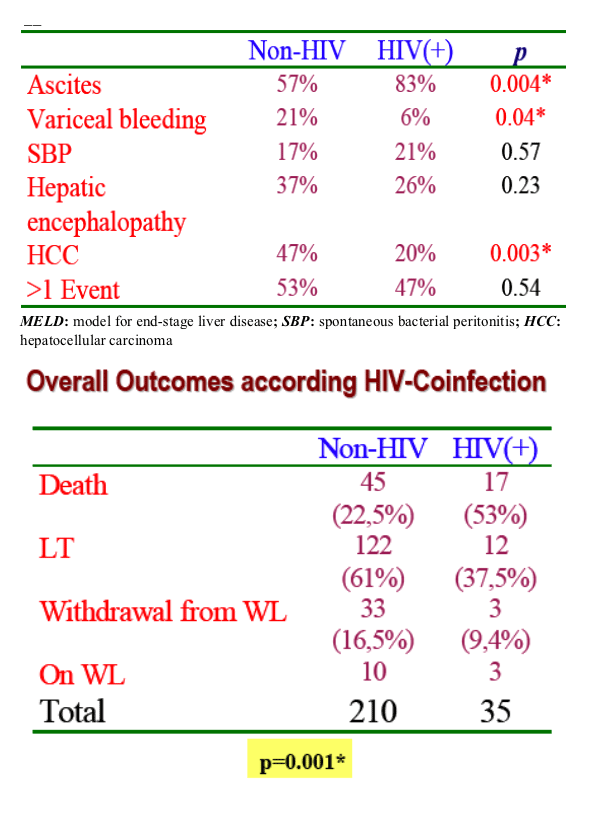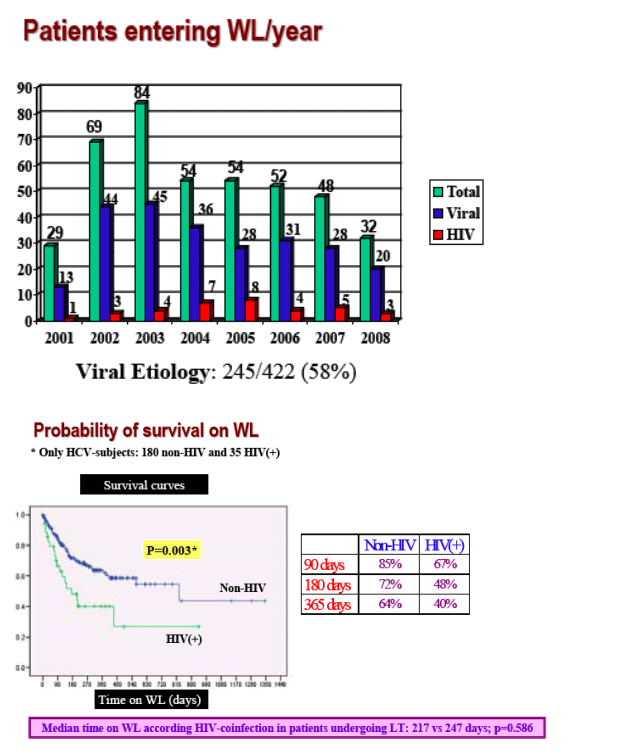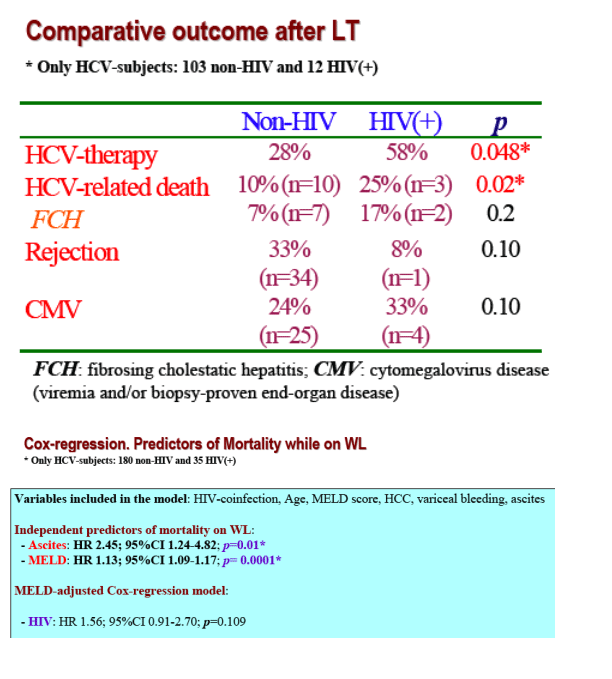 |
 |
 |
| |
Effect of HIV Co-infection on the Outcome of Viral Cirrhosis Liver Transplant Candidates on the Waiting List at a Reference Center from 2001 to 2008
|
| |
| |
"HCV and/or HBV-related cirrhosis is a leading cause of morbidity and mortality in HIV-coinfection. From July 2001, HIV-infection is not a contraindication for liver transplantation (LT) at our center"
AUTHOR CONCLUSIONS
1. HIV-infected patients with HCV or HCV/HBVsAg(+) cirrhosis had a signinfected significantly higher mortality on WL when
sgnificantly compared with noncompared non-HIV subjects (53% vs 22,5%).
2. Ascites and a higher MELD score at inclusion in the WL were independent predictors of mortality on WL. After
adjusting for MELD, HIV-coinfection showed a trend to adversely affect survival on WL (p=0.109).
3. Survival curves during the first 5 years after LT were similar in HIV(+) vs non-HIV subjects, but HIV-coinfected subjects more frequently needed peg-IFN/RBV, and all deaths in HIV(+) subjects were due to HCV recurrence.
4. After multivariate analysis, a higher MELD score and/or older age at inclusion in the WL were independent predictors of mortality after LT.
Reported by Jules Levin
CROI Montreal Feb 8-12
"HIV patients with HCV or HCV/HBsAg+ cirrhosis on the waiting list had significantly higher mortality than non-HIV subjects. Ascites and a higher MELD score were independent predictors of mortality. Survival after liver transplantation was similar in both groups, but HIV subjects more frequently needed peg-IFN/RBV and died due to HCV recurrence."
Ana Moreno*1, R Barcena2, S Del Campo2, A Muriel3, C Quereda1, M Perez-Elias1, J Casado1, J Fortun1, J Nuno4, and S Moreno1
1Ramon y Cajal Hospital, Madrid, Spain, Infectious Diseases; 2Ramon y Cajal Hospital, Madrid, Spain, Liver-Gastroenterology. Liver Transplant Unit; 3Ramon y Cajal Hospital, Madrid, Spain, Clinical Biostatistics; and 4Ramon y Cajal Hospital, Madrid, Spain, General and Digestive Surgery. Liver Transplant Unit
Background: Hepatitis C (HCV) or B virus (HBV) -related cirrhosis is a leading cause of morbidity and mortality in HIV-co-infection. Since July 2001, HIV-infection has not been considered a contraindication for liver transplantation at our center.
Methods: We wanted to evaluate the effect of HIV co-infection on the outcome of all subjects with viral cirrhosis included in our waiting list from July 2001 to July 2008, to assess, by Cox regression, independent predictors of survival on the waiting list, and to evaluate outcomes after liver transplantation.
Results: During the study period, 245 patients entered waiting list, 35 HIV-co-infected (14%), of whom 86% had HCV, 14% had HCV/hepatitis B surface antigen (HBsAg)+, none with isolated HBsAg+. The rates of liver transplantation, death, or withdrawal from the waiting list according to HIV co-infection were 37.5% vs 61%, 53% vs 22.5%, and 9.4% vs 16.5% (p = 0.001). The probability of survival on the waiting list at 90, 180, and 365 days was significantly lower among HIV subjects: 67% vs 85%, 48% vs 72%, and 40% vs 64%, respectively (p = 0.003). Independent predictors of mortality were a higher MELD score (HR 1.13, 95%CI 1.09 to 1.17, p = 0.0001) and prior or current ascites at the first evaluation in the liver transplantation unit (HR 2.45, 95%CI 1.24 to 4.82, p = 0.010). Adjusting for MELD, HIV co-infection showed a trend to negatively affect survival (HR 1.56, 95%CI 0.91 to 2.70, p = 0.109).. Among patients undergoing liver transplantation, there were no differences in the median time on the waiting list according HIV co-infection (217 vs 247 days, p = 0.586), nor in the probability of survival at 1, 2, 3, and 5 years: 100% vs 71%, 75% vs 60%, 75% vs 57%, and 50% vs 53% (p = 0.336). However, the rates of pegylated interferon (pegIFN)+ribavirin (RBV) use (58% vs 28%, p = 0.048) and HCV recurrence-related death (3 of 3 or 100% vs 10 of 42 or 24%, p = 0.02) were higher among HIV subjects.
Conclusions: HIV patients with HCV or HCV/HBsAg+ cirrhosis on the waiting list had significantly higher mortality than non-HIV subjects. Ascites and a higher MELD score were independent predictors of mortality. Survival after liver transplantation was similar in both groups, but HIV subjects more frequently needed peg-IFN/RBV and died due to HCV recurrence.




|
| |
|
 |
 |
|
|